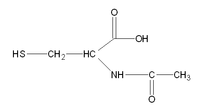Acetylcysteine
|
|
| N-acetyl L-cysteine | |
| CAS number 616-91-1 | ATC code R05CB01, S01XA08 and V03AB23 |
| Chemical formula | C5H9NO3S |
| Molecular weight | 163.196 |
| Bioavailability | ? |
| Metabolism | ? |
| Elimination half-life | ? |
| Excretion | ? |
| Pregnancy category | ? |
| Legal status | ? |
| Routes of administration | ? |
N-acetylcysteine is a chemical, commonly called NAC, produced by the body that enhances the production of the molecule glutathione, a powerful antioxidant. NAC is a thiol, in which the hydrogen atom can act to reduce free radicals.
In the United States, NAC is available as an over the counter supplement in health stores and in an oral solution as Mucomyst® that can be ingested or aerosolized and inhaled. Outside of the United States, it is available in pharmacies as an over the counter oral medicine and also available in an intravenous form as Parvolex®.
NAC has different uses in the treatment of medical conditions:
- NAC is used as a mucolytic ("mucus dissolving") agent to help break up the thick mucus often present in people suffering from respiratory ailments (e.g. flu, bronchitis, sinusitis), which it accomplishes by the splitting of disulphide bonds in mucoproteins. In more severe cases, like chronic respiratory conditions, it is given as an inhaled mist.
- When NAC is administered either intravenously or orally, it may be used in the treatment of acetaminophen (paracetamol) overdose in order to protect the liver from damage caused by toxic metabolites that exhaust glutathione stores.
- Incidence of radiocontrast-induced nephropathy (renal failure) decreases markedly (90%) if NAC is administered (Tepel et al 2000). Hoffman et al (2004) and Miner cast some doubt on its use, but NAC is still commonly used in individuals with renal insufficiency to prevent acute renal failure.
- Studies indicate that NAC can also be used to lessen the symptoms and duration of the flu and the common cold.
- It is used by AIDS patients, whose glutathione levels are depressed, and also by bodybuilders, whose intense training causes temporary lower levels of glutathione.
- NAC may also be useful in the treatment of cocaine addiction and in the removal of mercury from the body.
- Studies suggest that NAC, taken together with Vitamin C and B1 can be used to prevent and relief symptoms of veisalgia (hangover caused by alcohol). The primary detoxification mechanism for scavenging unmetabolized acetaldehyde (product of alcohol dehydrogenase) is sulfur-containing antioxidants. Cysteine and glutathione are active against acetaldehyde because they contain a reduced (unoxidized) form of sulfur called a sulfhydryl group, which contains a sulfur atom bonded to a hydrogen atom (abbreviated SH). Another study indicates, that N-acetylcysteine generally regresses the oxidative damage induced by alcohol.
References
- Hoffmann U, Fischereder M, Kruger B, Drobnik W, Kramer BK. The value of N-acetylcysteine in the prevention of radiocontrast agent-induced nephropathy seems questionable. J Am Soc Nephrol 2004;15:407-10. Fulltext (http://www.jasn.org/cgi/content/full/15/2/407). PMID 14747387.
- Miner SE, Dzavik V, Nguyen-Ho P, Richardson R, Mitchell J, Atchison D, Seidelin P, Daly P, Ross J, McLaughlin PR, Ing D, Lewycky P, Barolet A, Schwartz L. N-acetylcysteine reduces contrast-associated nephropathy but not clinical events during long-term follow-up. Am Heart J 2004;148:690-5. PMID 15459602.
- Tepel M, van der Giet M, Schwarzfeld C, Laufer U, Liermann D, Zidek W. Prevention of radiographic-contrast-agent-induced reductions in renal function by acetylcysteine. N Engl J Med 2000;343:180-4. PMID 10900277.
External links
- N-AcetylCysteine (NAC) (http://www.benbest.com/nutrceut/NAC.html)de:Acetylcystein

